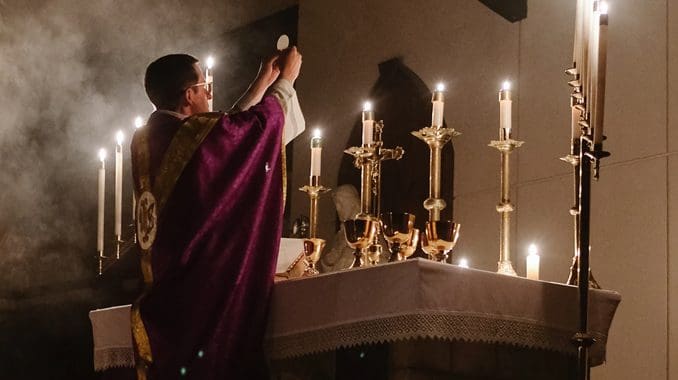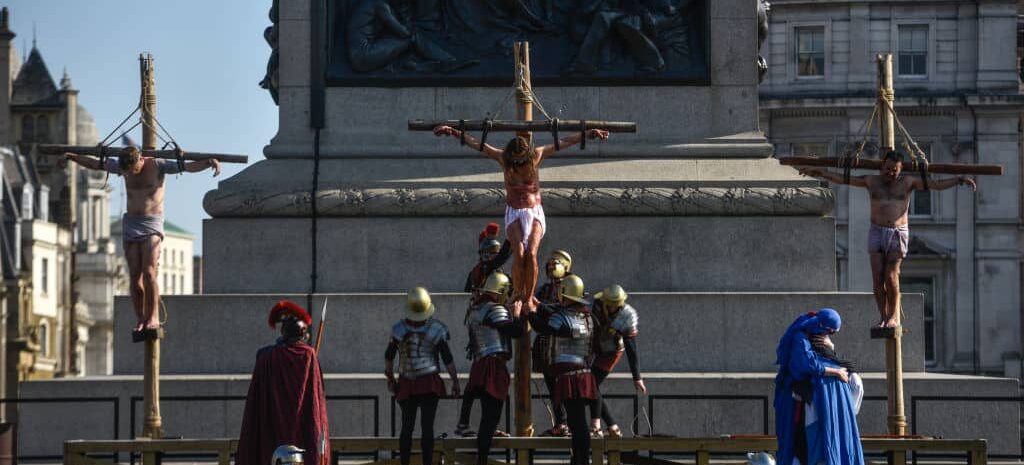There is no way that our current “liturgy wars” can be resolved until we once again become a Church that lives the entirety of its life as an “ad orientem” Church.
I was recently reading an article on a traditionalist site, posted by a friend of mine on his Facebook page. I do not normally read articles from such sources as I consider them, in general, to be devoted to a retrograde form of “angry Catholicism”. However, the topic was ad orientem worship, which piqued my interest. In the midst of an otherwise decent analysis the author casually stated that only “ad orientem” worship was proper since it is altogether fitting that the priest should “face God” in the tabernacle rather than turning his back on the same. I certainly do not believe that all traditionalists think this way; however, it does seem to be a misconception shared by many.
Joseph Ratzinger, in his 1986 book The Feast of Faith: Approaches to Theology of the Liturgy addressed this very topic, stating:
The eastward-facing position of the celebrant in the old Mass was never intended as a celebration toward the holy of holies, nor can it be described as “facing the altar”. In fact it would be contrary to all theological reason, since the Lord is present in the Eucharistic gifts during the Mass in the same way as he is in the gifts of the tabernacle which come from the Mass. Thus, the Eucharist would be celebrated “from” the Host “to” the Host, which is plainly meaningless. There is only one inner direction of the Eucharist, namely, from Christ in the Holy Spirit to the Father. The only question is how this can be best expressed in liturgical form.
Ratzinger goes on to point out that the tradition of facing east was grounded in the iconic symbolism of the rising sun (Son). It was thoroughly eschatological in tone and tenor since the symbolism involved focused on the Resurrection as a proleptic “looking forward” to the Parousia and the consummation of the Kingdom at the end of terrestrial time. The emphasis was on the full cosmic nature of our redemption. This necessarily included a Trinitarian emphasis not only on the work the Son, but also of the Father’s “power” over all of creation and the transformative role of the Holy Spirit in mediating the manner in which Christ makes “all things new.”
Thus the tradition arose of placing a cross on the east wall of the Church, which became the eschatological focus of all Eucharistic worship for priest and congregation alike. Sadly, over time this eschatological/trinitarian/cosmic dimension was eclipsed and then lost as the focus became almost exclusively the sacrifice of Christ on the cross. The sacrificial aspects of the Mass, though most certainly important, crowded out the eschatological horizon of the liturgical action. Thus, as Ratzinger notes, with this loss of eschatological orientation,
…the ancient eastward orientation of the celebration became meaningless, and people could begin speaking of the priest celebrating ‘facing the wall’ or imagine that he was celebrating toward the tabernacle.
This loss of the eschatological horizon, already operative in the pre-conciliar liturgy, is why versus populum worship was also immediately misunderstood as a “dialogue” between priest and people. After all, once the eschatological horizon is lost it does seem to be the case that it is better for the priest to face the people rather than “the wall” or the tabernacle. As Ratzinger states:
This misunderstanding alone can explain the sweeping triumph of the new celebration facing the people. … All this would be inconceivable if it had not been preceded by a prior loss of meaning from within.
Ratzinger clearly prefers a return to the prior form of priest and people facing the eschatological east together. But he believes that to institute such a reversion now would only further confuse people who have endured enough liturgical tinkering already. Better for now, at least as a stop-gap measure, to place a large crucifix on the altar where it is plainly visible and which becomes the focus of both priest and congregation. This has the added advantage as well of emphasizing that what makes the liturgy “ad orientem” is not the posture or position of the priest vis-à-vis the people as such, but the eschatological horizon that is the very heart and soul of what ad orientem meant in the first place.
In other words, the entire congregation could be on their backs looking at the ceiling during worship, but if it contains a strong eschatological focus on the cosmic Christ then, in some way (and no matter how bizarre my example) the worship is “ad orientem”.
However, I think even Ratzinger understands that his “crucifix on the altar” solution is, at best, a partial and ultimately unsatisfactory answer. It does not address the deeper issue of a Church that has become overly horizontalist and has lost its eschatological edge—a fact the “new Mass” perhaps exacerbates. But, for that matter, absent such a reinvigorated eschatological sense, a mere return to the priest facing away from the people will not solve matters either. Because, as we have seen, this too is open to misunderstanding when the original meaning of ad orientem worship has been lost.
The Italian philosopher Giorgio Agamben, in a lecture given to various Catholics assembled at Notre Dame Cathedral in Paris, made the claim that this is precisely the broader crisis in the Church today as a whole. The first Christians, he states, had a thought world utterly dominated by the eschatological sense of “Messianic time,” which for Agamben means the first Christians saw themselves as “sojourners.” They were a people “on the move” from Christ and to Christ; the Church, according to Agamben, has lost this eschatological edge. We are now “settled citizens” content with the ambient cultures that surround us and the stasis of a “time” devoid of eschatological orientation.
I agree with this, and what it says to me is that there is no way that our current “liturgy wars” can be resolved until we once again become a Church that lives the entirety of its life as an “ad orientem” Church. Only such a Church will have the inner resources to once again “turn to the east” with an expectant faith oriented to the cosmic Glory that is to come.
This article originally appeared at Catholic World Report and can be found here.
Dr. Larry Chapp is a retired professor of theology. He taught for twenty years at DeSales University near Allentown, Pennsylvania. He now owns and manages, with his wife, the Dorothy Day Catholic Worker Farm in Harveys Lake, Pennsylvania. Dr. Chapp received his doctorate from Fordham University in 1994 with a specialization in the theology of Hans Urs von Balthasar. He can be visited online at “Gaudium et Spes 22”.
Image Source: Image: Josh Applegate | Unsplash.com



